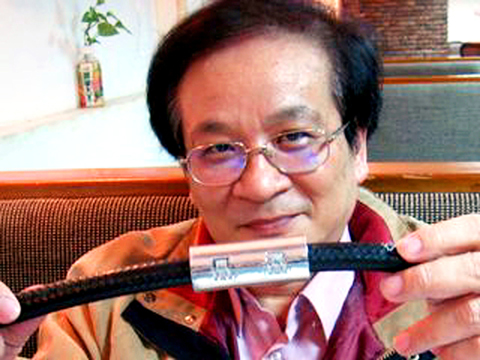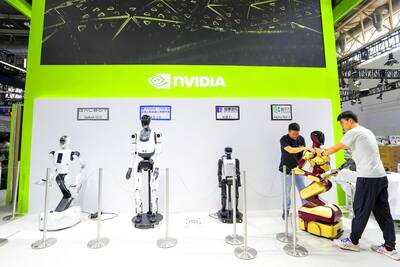It has taken Taiwanese inventor Suilliven Wang (王順炫) 10 years and cost him nearly NT$100 million (US$3.1 million) to develop his device, which helps vehicles save fuel. To Wang, it’s about time he reaped the fruits of his hard work.
After rejecting China as a manufacturing base for fear of piracy, Wang is now seriously considering cooperating with Chinese firms, including state-owned enterprises, as China — with its booming vehicle purchases — is turning out to be a key market for him.
His story epitomizes the persistence of Taiwanese innovators, who are increasingly encouraged by the government to help turn Taiwan into an innovation-driven economy. The path they travel, however, is full of challenges.

PHOTO: CNA
Wang, who used to be a refrigerator design engineer in the early 1980s, started his initial research on the fuel saver in 1994. With guidance from a local scientific expert, Wang devoted himself to developing the fuel saver, which uses nanotechnology, in 1997.
The fuel-saver, a 10cm metal tube attached with a piece of nano-filled rubber inside, can help reduce carbon emissions of a diesel passenger car by 40 percent.
Wrapped around a vehicle’s fuel pipe, the device creates far-infrared rays, which can help minify fuel’s molecules, enhance complete combustion, and thus cut down fuel consumption and reduce carbon emissions.
Within nine years, Wang received a patent for the device in Taiwan and China, and passed a fuel-saving test on cars in China as well as a smoke-reducing test in Singapore.
“When the device was first tested in China, the inspection center tested it three times,” Wang said, “because it was difficult for them to believe that the device was able to save 20 percent of fuel [at that time], especially because back then the best fuel saver could only save about 6 percent of the fuel.”
The center then decided to set up a review panel, asking Wang what made the little device work.
“It speeds up the collision [of fuel molecules],” Wang said, adding that the nano far-infrared material in the fuel saver can boost fuel segmentation, decrease viscosity of fuel and make combustion easier.
The formula for Wang’s nano material suddenly became a hit.
Wang soon received an offer from a Chinese organization to invest 30 million yuan (US$4.4 million), but he rejected the offer.
“They asked me to provide the formula,” Wang said. “I just want to keep the best technology in Taiwan.”
Wang admitted that he put some bugs in the device, therefore less than half of the 26 types of formula can be found through lab tests.
“I was just taking necessary measures,” he said.
He said last week that while he would forsake making his product in the Chinese market, he hoped to sell more of the product there.
“I definitely will not go to China. My product might be copied by others if I set up a plant in China,” Wang said, adding that he was determined to establish his production base in Taiwan.
Four months ago, an investment company in the US came to Wang, offering an investment of US$1.2 billion for setting up a joint company with Wang’s Toneching Enterprise Co (唐慶興業) and establishing a large manufacturing base in Taiwan.
Wang finally gave the nod. The investment is under review by the Investment Commission of the Ministry of Economic Affairs.
Wang’s company produces 50,000 fuel savers per month, with 80 percent exported to China and 20 percent sold in Taiwan and some Southeast Asian countries, such as Malaysia and Indonesia.
After the new company is set up in the first half of this year, production output is expected to increase by 30 times to 1.5 million units per month in the first three years, with China as the top priority market, Wang said.
“New vehicle sales in China are estimated at about 1.2 million units per month. We hope to grab the market as soon as we can,” he said.
At present, the fuel saver sells for 1,200 yuan apiece. When it enters mass production, the price is likely to be much lower — dropping by as much as 80 percent, Wang said.
For a passenger car driving an average of 5,000km a month, the cost recovery time for installing one fuel saver on a car is about two-and-a-half months, Wang said.
Compared with his ambitions toward the Chinese market, however, Wang seemed more conservative about expanding in the local market.
“It takes me too much time to persuade people here,” Wang said, adding that local auto maintenance shops lacked trust as most fuel savers on the market do not work as effectively as the makers claim.
Furthermore, most people think a fuel-saving device only works for one year and they will not see it as a must-buy product if it only saves between 5 percent and 8 percent of fuel, Wang said.
In December 2007, Wang went to the Taiwan Taxi Co (台灣大車隊), the country’s largest taxi company with 6,000 taxis in service nationwide, to ask the company to help test the fuel saver’s functionalities.
Taiwan Taxi chairman Lin Tsun-tien (林村田) also expressed doubts, as there were dozens of similar products on the market.
But he still decided to give Wang a chance.
Lin assigned three taxi drivers to help test the device, which proved to be able to save between 31 percent and 53 percent of fuel at a driving distance of 100km.
An engineer from the Automotive Research and Testing Center established by the Ministry of Economic Affairs said most fuel savers did not perform well in tests, but he also said that there is a gray area among promoting such products.
“Everyone drives in a different way, so the results of using fuel savers may also be different,” the engineer said. “You can not say for sure that the product is effective or not.”
Although Wang doesn’t want to make his product in China, he is keenly aware that China will still be one of his most important markets.
With an injection of foreign funds expected in the near future, Wang is eyeing not only the booming Chinese market, but also the growing market in India.
“Only the Chinese and Indian governments are likely to order every new vehicle on the market to be installed with such fuel saver,” said Wang, who was optimistic about the outlook for his new company.
In fact, after passing the inspection in China with eye-opening results, Wang has already been offered some business opportunities in China.
“The inspection report is just like a diploma. I had to obtain it before doing business with state enterprises in China,” Wang said.
He said, however, that he would hold tight to his secret formula.

UNCERTAINTIES: Exports surged 34.1% and private investment grew 7.03% to outpace expectations in the first half, although US tariffs could stall momentum The Chung-Hua Institution for Economic Research (CIER, 中華經濟研究院) yesterday raised its GDP growth forecast to 3.05 percent this year on a robust first-half performance, but warned that US tariff threats and external uncertainty could stall momentum in the second half of the year. “The first half proved exceptionally strong, allowing room for optimism,” CIER president Lien Hsien-ming (連賢明) said. “But the growth momentum may slow moving forward due to US tariffs.” The tariff threat poses definite downside risks, although the scale of the impact remains unclear given the unpredictability of US President Donald Trump’s policies, Lien said. Despite the headwinds, Taiwan is likely

When Lika Megreladze was a child, life in her native western Georgian region of Guria revolved around tea. Her mother worked for decades as a scientist at the Soviet Union’s Institute of Tea and Subtropical Crops in the village of Anaseuli, Georgia, perfecting cultivation methods for a Georgian tea industry that supplied the bulk of the vast communist state’s brews. “When I was a child, this was only my mum’s workplace. Only later I realized that it was something big,” she said. Now, the institute lies abandoned. Yellowed papers are strewn around its decaying corridors, and a statue of Soviet founder Vladimir Lenin

UNIFYING OPPOSITION: Numerous companies have registered complaints over the potential levies, bringing together rival automakers in voicing their reservations US President Donald Trump is readying plans for industry-specific tariffs to kick in alongside his country-by-country duties in two weeks, ramping up his push to reshape the US’ standing in the global trading system by penalizing purchases from abroad. Administration officials could release details of Trump’s planned 50 percent duty on copper in the days before they are set to take effect on Friday next week, a person familiar with the matter said. That is the same date Trump’s “reciprocal” levies on products from more than 100 nations are slated to begin. Trump on Tuesday said that he is likely to impose tariffs

READY TO BUY: Shortly after Nvidia announced the approval, Chinese firms scrambled to order the H20 GPUs, which the company must send to the US government for approval Nvidia Corp chief executive officer Jensen Huang (黃仁勳) late on Monday said the technology giant has won approval from US President Donald Trump’s administration to sell its advanced H20 graphics processing units (GPUs) used to develop artificial intelligence (AI) to China. The news came in a company blog post late on Monday and Huang also spoke about the coup on China’s state-run China Global Television Network in remarks shown on X. “The US government has assured Nvidia that licenses will be granted, and Nvidia hopes to start deliveries soon,” the post said. “Today, I’m announcing that the US government has approved for us